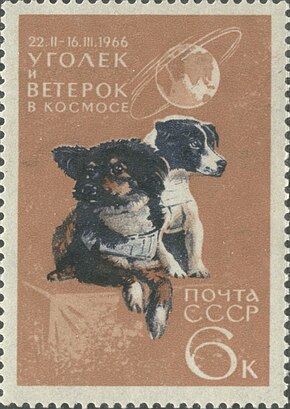
Back Космос 110 Bulgarian Kosmos 110 German Cosmos 110 Spanish Kosmos 110 Finnish Koszmosz–110 Hungarian Kosmos 110 Italian コスモス110号 Japanese Космос-110 Macedonian Kosmos 110 Dutch Kosmos 110 Polish
 | |
| Mission type | Biosciences |
|---|---|
| Operator | OKB-1 |
| COSPAR ID | 1966-015A |
| SATCAT no. | 2070 |
| Mission duration | 21 days, 17 hours and 59 minutes |
| Spacecraft properties | |
| Spacecraft | Voskhod 3KV No.5 |
| Spacecraft type | Voskhod 3KV |
| Manufacturer | OKB-1 |
| Launch mass | 5700 kg[1] |
| Start of mission | |
| Launch date | 22 February 1966, 20:09:36 GMT |
| Rocket | Voskhod 11A57 |
| Launch site | Baikonur 31/6 |
| Contractor | OKB-1 |
| End of mission | |
| Disposal | Recovered |
| Landing date | 16 March 1966, 14:09 GMT |
| Landing site | Steppes of Kazakhstan, USSR |
| Orbital parameters | |
| Reference system | Geocentric orbit[2] |
| Regime | Low Earth orbit |
| Perigee altitude | 190 km |
| Apogee altitude | 882 km |
| Inclination | 51.9° |
| Period | 95.3 minutes |
Kosmos 110 (Russian: Космос 110 meaning Kosmos 110) was a Soviet spacecraft launched on 22 February 1966 from the Baikonur Cosmodrome aboard a Voskhod rocket. It carried two dogs, Veterok ("Breeze") and Ugolyok ("Little piece of coal").[3] It was one of the more eye-catching and popular experiments of the long series of Russian Kosmos satellites.[4]
- ^ "Display: Cosmos 110 1966-015A". NASA. 14 May 2020. Retrieved 16 January 2021.
 This article incorporates text from this source, which is in the public domain.
This article incorporates text from this source, which is in the public domain.
- ^ Cite error: The named reference
Trajectorywas invoked but never defined (see the help page). - ^ LMurray (5 November 2007). "Laika and Her "Children"---Animals in the Space Race". Saving Earth | Encyclopedia Britannica. Retrieved 30 March 2024.
- ^ Rich, Vera (13 April 1978). "Kosmos-1000 up" (PDF). Nature. 272: 574.
© MMXXIII Rich X Search. We shall prevail. All rights reserved. Rich X Search